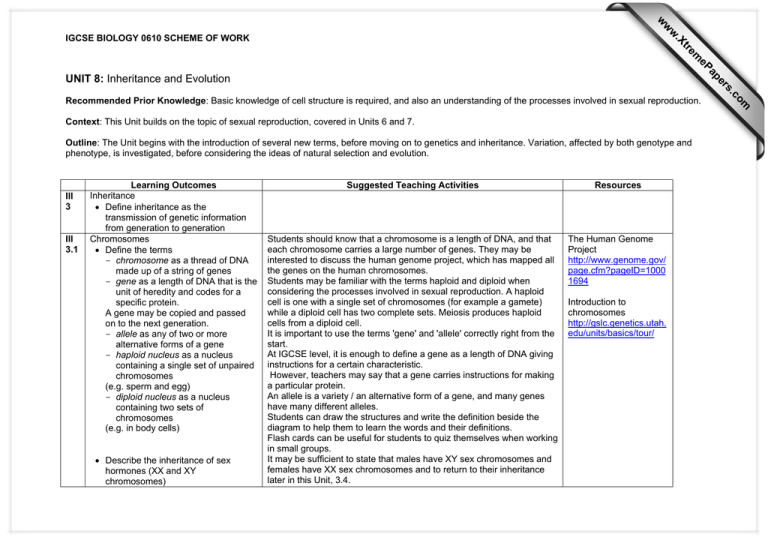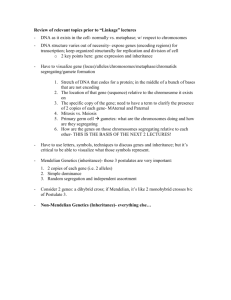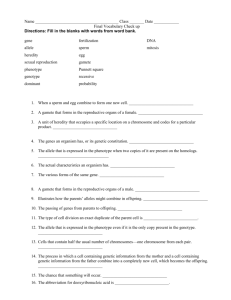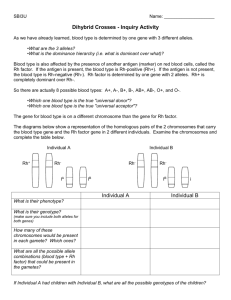UNIT 8:
advertisement

w w w 1 UNIT 8: Inheritance and Evolution Recommended Prior Knowledge: Basic knowledge of cell structure is required, and also an understanding of the processes involved in sexual reproduction. Context: This Unit builds on the topic of sexual reproduction, covered in Units 6 and 7. Outline: The Unit begins with the introduction of several new terms, before moving on to genetics and inheritance. Variation, affected by both genotype and phenotype, is investigated, before considering the ideas of natural selection and evolution. III 3 III 3.1 Learning Outcomes Inheritance • Define inheritance as the transmission of genetic information from generation to generation Chromosomes • Define the terms - chromosome as a thread of DNA made up of a string of genes - gene as a length of DNA that is the unit of heredity and codes for a specific protein. A gene may be copied and passed on to the next generation. - allele as any of two or more alternative forms of a gene - haploid nucleus as a nucleus containing a single set of unpaired chromosomes (e.g. sperm and egg) - diploid nucleus as a nucleus containing two sets of chromosomes (e.g. in body cells) • Describe the inheritance of sex hormones (XX and XY chromosomes) Suggested Teaching Activities Resources Students should know that a chromosome is a length of DNA, and that each chromosome carries a large number of genes. They may be interested to discuss the human genome project, which has mapped all the genes on the human chromosomes. Students may be familiar with the terms haploid and diploid when considering the processes involved in sexual reproduction. A haploid cell is one with a single set of chromosomes (for example a gamete) while a diploid cell has two complete sets. Meiosis produces haploid cells from a diploid cell. It is important to use the terms 'gene' and 'allele' correctly right from the start. At IGCSE level, it is enough to define a gene as a length of DNA giving instructions for a certain characteristic. However, teachers may say that a gene carries instructions for making a particular protein. An allele is a variety / an alternative form of a gene, and many genes have many different alleles. Students can draw the structures and write the definition beside the diagram to help them to learn the words and their definitions. Flash cards can be useful for students to quiz themselves when working in small groups. It may be sufficient to state that males have XY sex chromosomes and females have XX sex chromosomes and to return to their inheritance later in this Unit, 3.4. The Human Genome Project http://www.genome.gov/ page.cfm?pageID=1000 1694 Introduction to chromosomes http://gslc.genetics.utah. edu/units/basics/tour/ om .c s er ap eP m e tr .X IGCSE BIOLOGY 0610 SCHEME OF WORK IGCSE BIOLOGY 0610 SCHEME OF WORK III 3.4 Learning Outcomes Monohybrid inheritance • Define the following terms: - genotype as the genetic makeup - of an organism in terms of the alleles present (e.g. Tt or GG) - phenotype as the physical or other features of an organism due to both its genotype and its environment - (e.g. tall plant or green seed) - homozygous as having two identical alleles of a particular gene (e.g. TT or gg). Two identical homozygous individuals that breed together will be pure breeding - heterozygous as having two different alleles of a particular gene (e.g.Tt or Gg) and are not pure breeding - dominant as an allele that is expressed if it is present - (e.g. T or G) - recessive as an allele that is only expressed when there is no dominant allele of the gene present (e.g. t or g) • • • • • 2 Suggested Teaching Activities It is best to consider the meanings of these terms before thinking about inheritance. They can best be illustrated and explained with reference to a particular characteristic. Choose something simple, and that is likely to appeal to students, such as coat colour of an animal. The example does not have to be real. It should involve a gene with two alleles, one dominant and one recessive. Students should learn that one letter is used to represent these alleles, with an upper case letter for the dominant allele and a lower case letter for the recessive allele. They should also learn to write the dominant allele first. They will know that most cells are Diploid and so should be able to understand that they therefore carry two copies of each gene. The terms genotype, phenotype, homozygous and heterozygous can be introduced and defined in relation to simple genetic crosses. It is a good idea to spend some time with such examples, using a Punnett square for clarity especially with the Core students. Ensure that students are thoroughly confident using the terminology, before beginning to think about how inheritance occurs. Students should be reminded that gametes are haploid cells, and therefore carry only one copy of each gene. They can be asked to work out what kind of gametes will be produced by organisms with a range of different genotypes. It is good practice, and avoids confusion, if a circle is drawn around each gamete or the genotype when writing out a genetic cross. Discourage students from automatically writing down two gametes from each parent. This is only necessary if the parent is heterozygous and producing two different kinds of gamete. If it is homozygous, then only one kind of gamete is made, and only one needs to be written down. Students can then be introduced to the idea of random fertilisation, in which any kind of gamete from the male parent can fuse with any kind of gamete from the female parent. The offspring now have two copies of each gene again. Drawing lines from gamete to gamete often causes errors drawing a Punnett square is easier for students to understand. in the boxes, Resources Genotype and phenotype http://www.brooklyn.cun y.edu/bc/ahp/BioInfo/GP /Definition.html The understanding of genetic terms and questions need to be practised using as many questions as there is time for. IGCSE BIOLOGY 0610 SCHEME OF WORK Learning Outcomes • Calculate and predict the results of monohybrid crosses involving 1 : 1 and 3 : 1 ratios III 3.4 Supplement • Explain codominance by reference to the inheritance of ABO blood groups and phenotypes, A,B,AB and O blood groups and genotypes IA,IB and 1o III 3.5 Variation. • State that continuous variation is influenced by genes and environment, resulting in a wide range of phenotypes between two extremes - e.g. height in humans 3 Suggested Teaching Activities Ensure that students understand that what they have worked out is the probability of particular genotypes being produced. The fact that, for example, four different genotypes are present amongst the offspring does not mean that the parents will have four children. Students need to be familiar with the monohybrid crosses 1:1 and 3:1 The inheritance of sex can be dealt with in the same way as the inheritance of genes, but this time the symbols X and Y are used to indicate whole chromosomes, not alleles of a gene. Students should be able to draw genetic crosses to show the expected. 1:1 ratio Codominance is the combination of two different alleles that will produce an effect that is a mixture of both of them. The correct use of symbols should be encouraged; where codominance exists, the gene is shown with an upper case letter, with superscripts to represent the different alleles. It is helpful to write down a list of all the possible genotypes for blood groups and the resulting phenotypes before attempting to deal with any crosses. Ensure that the correct symbols, as used in the syllabus, are automatically used by students. Continuous variation can be illustrated by almost any characteristic that is measurable on a human: height, length of middle finger wrist circumference will each give a good range of results and not cause any embarrassment. Leaves or other plant material can also be used to generate a range of results. Students can see that a range of values is obtained. To show them graphically, they will need to decide on 6 or 7 ranges and then draw up a tally chart to show how many values fit into each range. These can then be plotted on a histogram. Resources Variation – continuous and discontinuous http://www.bbc.co.uk/sc otland/revision/biology/in heritance/variation_and_ genetics_and_society_r ev.shtml IGCSE BIOLOGY 0610 SCHEME OF WORK III 3.5 4 Learning Outcomes Suggested Teaching Activities A common misconception is that 'continuous variation' means something that changes through your life. Although this is true of the measurements students are likely to have made to illustrate this, it is not the correct meaning of the term. Use other features, such as hair or eye colour, to emphasise the real meaning of continuous variation. • State that discontinuous variation is caused by genes alone and results in a limited number of distinct phenotypes with no intermediates - e.g. A, B, AB, O blood groups in humans Students studying the supplement will already be familiar with the A, B, AB and O blood groups. Blood groups are a good example of discontinuous variation. Students can draw bar charts to show the relative proportions of people with the four blood groups. They will not find it difficult to understand that everyone fits into one of these four categories, with no in-betweens, and this is therefore an example of discontinuous variation. A second example is gender. Students should understand that discontinuous variation is caused purely by genes but continuous variation often involves influence by the environment as well. • Define mutation as a change in a gene or chromosome Mutation can be defined as an unpredictable change in the DNA content of a cell. It can affect a single gene, or whole chromosomes, and can happen at any stage, not only during cell division. Mutations can be positive for an organism, as in bacteria that developed resistance to certain antibiotics. ref 3.6 of this unit. Down's syndrome is used to illustrate a mutation that occurs during meiosis and affects the number of chromosomes in a cell. Students could look at karyotypes of people with Down's syndrome, and compare them with karyotypes of males and females with the normal number of chromosomes. • Describe mutation as a source of variation, as shown by Down's syndrome • Outline the effects of ionising radiation and chemicals on the rate of mutation. Ionising radiation and mustard gas can be given as examples of factors that may cause mutations. Chernobyl in 1984 is an example of radiation that caused mutations in hundreds of people and unborn babies. The Fukushima nuclear disaster in Japan in 2011 will probably be the cause of mutations Resources Inheritance patterns in monogenic disorders http://www.gig.org.uk/ed ucation2.htm Down’s syndrome as an example of mutation http://www.bbc.co.uk/he alth/physical_health/con ditions/downssyndro IGCSE BIOLOGY 0610 SCHEME OF WORK III 3.5 III 3.6 5 Learning Outcomes Supplement • Describe sickle cell anaemia and explain its incidence in relation to that of malaria Suggested Teaching Activities Sickle cell anaemia can be explained as the result of a mutation in the gene that codes for the production of haemoglobin. The effects of this on the carriage of oxygen, and the consequences for respiring cells in body tissues, can be discussed. Its inheritance can also be considered. Students can look at maps showing the distribution of malaria and of sickle cell anaemia. Some students may have some degree of sickle cell anaemia and will be able to talk about it to the class. .It is a good way to introduce the ideas of selection pressures, and natural selection. It can be related to the slave trade and its occurrence in the States. Selection. • Describe the role of artificial selection in the production of varieties of animals and plants with increased economic importance. Students are already aware that variation occurs within populations of organisms, and they will not find it difficult to think how humans may choose a particular variety of an animal or plant, and use this to breed from. Examples include. Jersey cattle that have a high milk yield Wheat that has high seed yield and shorter stems that are easier to harvest Rice that has roots tolerant to lactic acid in the water . Maize has been bred to be able to adapt to low carbon dioxide concentrations. It should be made clear that this selection needs to continue for many generations, and does not produce immediate results. The favourable characteristics are expressed in the phenotypes in some of the offspring and these offspring may be better able to survive and reproduce in a particular environment. If students have already studied sickle cell anaemia, they will already have thought about the ideas of differential survival and selection. These will pass on their alleles to their offspring, so that the alleles that confer the advantageous characteristics gradually become more common. Over time, this could lead to a change in the overall characteristics of the species. • Define natural selection as the greater chance of passing on of genes by the best adapted organisms Resources http://www.cuhk.edu.hk/ med/paf/slides/hematolo /xv-19.htmme1.shtml IGCSE BIOLOGY 0610 SCHEME OF WORK Learning Outcomes Supplement • Describe variation and state that competition leads to differential survival of, and reproduction by, those best fitted to the environment • Assess the importance of natural selection as a possible mechanism for evolution 6 Suggested Teaching Activities The development of antibiotic-resistant strains of bacteria makes a good example to illustrate the ideas in the previous section. Changes in a species through natural selection over time are gradual due to environmental changes and can be a mechanism for evolution. Students are interested in this topic and groups within the class could present some ideas to the whole class. Bacteria reproduce rapidly and a slight mutation during asexual reproduction can produce some variation within the population. Bacteria that survive and reproduce may develop a resistance to the antibiotic that was meant to kill them. This successful, mutated bacterium will reproduce and pass on the antibiotic resistant gene to its offspring. Resources Simulated evolution http://home.pacbell.net/s -max/scott/simevol.html Use simple diagrams of bacteria containing circular DNA to show how a section of human DNA can be inserted into the bacterial DNA. Explain that DNA can be cut in certain places using different restriction enzymes to select the correct gene. If the same restriction enzyme is used to cut the bacterial DNA then the ends of the human and bacterial DNA will stick together. Description of human insulin production http://www.tiscali.co.uk/r eference/encyclopaedia/ hutchinson/m0007839.ht ml • Describe the development of strains of antibiotic resistant bacteria as an example of natural selection III 3.7 Genetic Engineering • Define genetic engineering as taking a gene from one species and putting it into another species Supplement • Explain why, and outline how, human insulin genes were put into bacteria using genetic engineering IGCSE BIOLOGY 0610 SCHEME OF WORK 7







